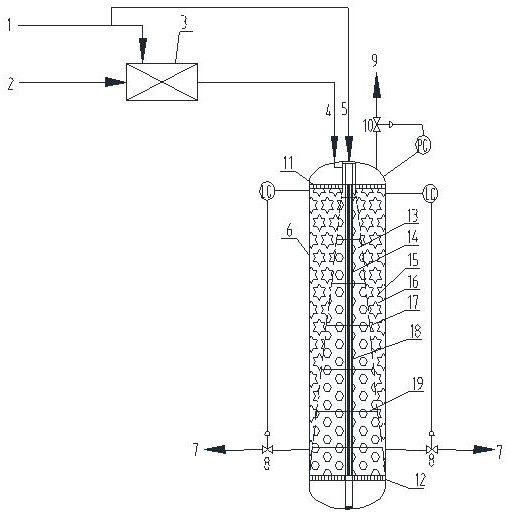A liquid phase hydrogenation reactor and hydrogenation process
A liquid-phase hydrogenation and hydrogenation reaction technology, which is applied in the fields of hydrogenation treatment process, sustainable manufacturing/processing, petroleum industry, etc., can solve problems such as side reactions and cracking reactions, severe reaction heat release, and fast reaction rate
- Summary
- Abstract
- Description
- Claims
- Application Information
AI Technical Summary
Problems solved by technology
Method used
Image
Examples
Embodiment 1
[0049] with attached figure 1 In the described method, the catalyst used in the conical inner cylinder of the liquid-phase hydrogenation reactor is FHDO-18 of Fushun Petrochemical Research Institute, and the catalyst used in the annular cavity is FHDO-10; the liquid-phase hydrogenation reactor feed contains FHDO-18. The amount of hydrogen in the liquid phase hydrogenation reactor is 0.015% of the mass of the feedstock oil, and the hydrogen supplementation amount of the hydrogen diffusion component of the liquid phase hydrogenation reactor is 0.112% of the mass of the feedstock oil; the reaction conditions of the conical inner cylinder of the liquid phase hydrogenation reactor are as follows: the reaction The temperature is 121.2~124.7℃, the reaction pressure is 1.8MPaG, and the liquid hourly volume space velocity is 15.0h -1 ; The reaction conditions of the annular cavity are as follows: the reaction temperature is 124.7~128.1℃, the reaction pressure is 1.75MPaG, and the liqui...
Embodiment 2
[0053] with attached figure 1 In the described method, the catalyst used in the conical inner cylinder of the liquid-phase hydrogenation reactor is FHDO-10 of Fushun Petrochemical Research Institute, and the catalyst used in the annular cavity is FHDO-6; the liquid-phase hydrogenation reactor feed contains FHDO-6. The amount of hydrogen supplied is 0.012% of the mass of the feedstock oil, and the hydrogen supplementation of the hydrogen diffusion component of the liquid-phase hydrogenation reactor is 0.117% of the mass of the feedstock oil. The reaction conditions of the conical inner cylinder of the liquid-phase hydrogenation reactor are as follows: the reaction temperature is 122.4~125.8℃, the reaction pressure is 1.8MPaG, and the liquid hourly volume space velocity is 12.0h -1 ; The reaction conditions of the annular cavity are as follows: the reaction temperature is 125.8-129.2°C, the reaction pressure is 1.75MPaG, and the liquid hourly volume space velocity is 8.8h -1 . ...
Embodiment 3
[0057] with attached figure 1 In the method, the catalyst used in the conical inner cylinder of the liquid-phase hydrogenation reactor is FHDO-18 from Fushun Petrochemical Research Institute, and the catalyst used in the annular cavity is FHDO-6; the liquid-phase hydrogenation reactor feed contains FHDO-6. The amount of hydrogen in the liquid phase hydrogenation reactor is 0.025% of the mass of the feedstock oil, and the hydrogen supplementation of the hydrogen diffusion component of the liquid-phase hydrogenation reactor is 0.104% of the mass of the feedstock oil. The reaction conditions of the conical inner cylinder of the liquid-phase hydrogenation reactor are as follows: the reaction temperature is 120.7~124.2℃, the reaction pressure is 1.8MPaG, and the liquid hourly volume space velocity is 12.0h -1 ; The reaction conditions of the annular cavity are as follows: the reaction temperature is 124.2~127.5℃, the reaction pressure is 1.75MPaG, and the liquid hourly volume space...
PUM
| Property | Measurement | Unit |
|---|---|---|
| size | aaaaa | aaaaa |
| pore size | aaaaa | aaaaa |
| porosity | aaaaa | aaaaa |
Abstract
Description
Claims
Application Information
 Login to View More
Login to View More - R&D
- Intellectual Property
- Life Sciences
- Materials
- Tech Scout
- Unparalleled Data Quality
- Higher Quality Content
- 60% Fewer Hallucinations
Browse by: Latest US Patents, China's latest patents, Technical Efficacy Thesaurus, Application Domain, Technology Topic, Popular Technical Reports.
© 2025 PatSnap. All rights reserved.Legal|Privacy policy|Modern Slavery Act Transparency Statement|Sitemap|About US| Contact US: help@patsnap.com



